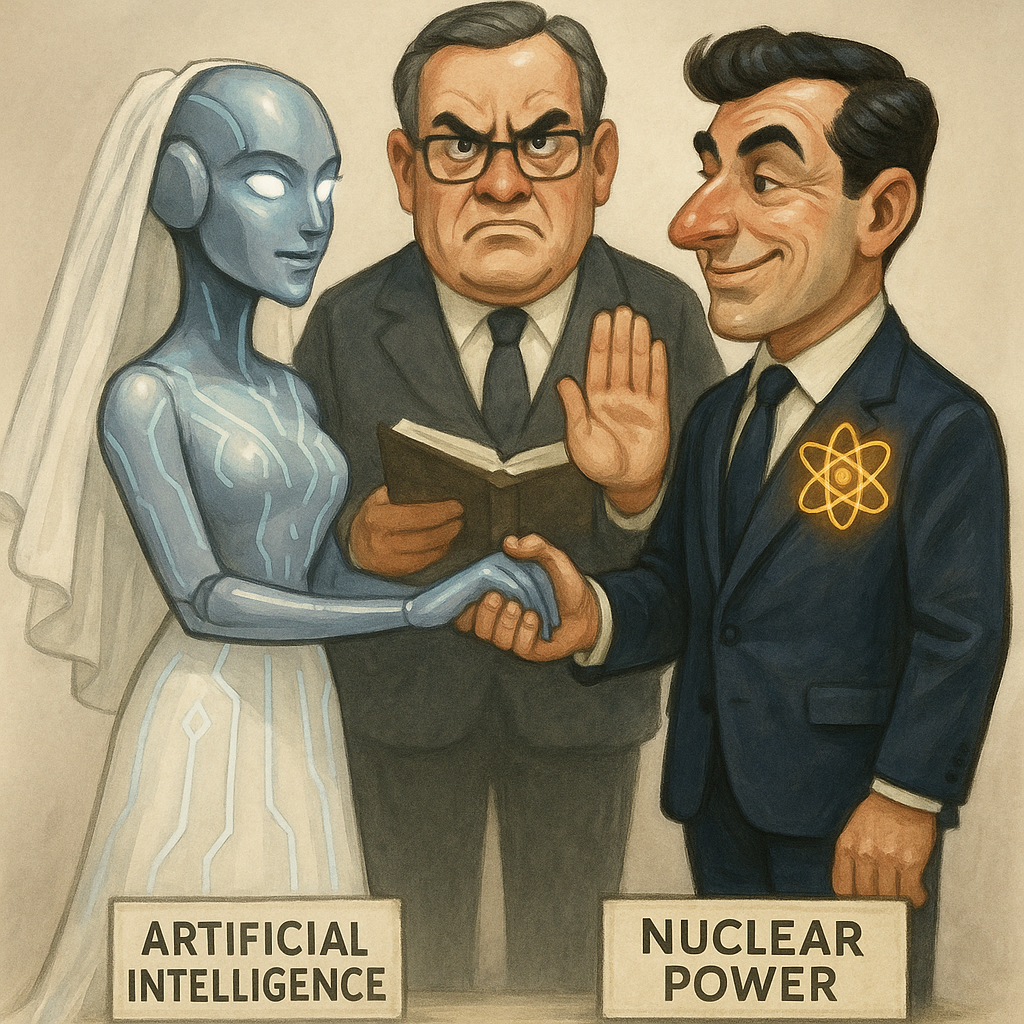- Are 676% and 661% profits enough for you?
- AI and nuclear power are in for a tumultuous relationship
- How to profit from power grid chaos
It’s the moment all grooms fear most. The celebrant asks all those assembled whether anyone has any objection. Someone at the back stands up, takes a deep breath and unleashes chaos…
Well, back in November, the marriage between AI and nuclear experienced just such a moment. But the investment world still hasn’t caught on to the consequences.
Stock markets still seem to think the combination of AI and nuclear power is the investment story of the decade. But I’m getting worried about the couple…
Subscribers to my newsletter in Australia already took 676% profits on the AI nuclear trade back in February. And are sitting on 661% gains in a second position.
Perhaps I should close the second position too?
Why?
Bigamy, of all things.
The US government caught nuclear power and AI in the act. And rejected their marriage application.
But will this be the end of the relationship?
Will nuclear investors see their exceptional returns on the back of AI power demand wiped out?
Or will Ms AI and Mr Nuclear take their affair behind closed doors to consummate?
To figure it out, we’d better start from the beginning…
Why AI and nuclear power are such a good match
The AI data centre boom is triggering a vast boom in baseload power demand. It has completely rewritten projections for electricity demand in countries that have any spare capacity. And AI data centre companies are avoiding the countries that don’t have any spare capacity.
AI’s power demand isn’t just big. It comes as a shock to an unprepared system. Electricity demand had been strangely stable for years in industrialised countries. There are all sorts of reasons for this. Deindustrialisation is one of them, funnily enough.
Suddenly, AI is causing a boom. But the system isn’t ready for growth. It was supposed to be in a managed decline over emissions rules instead.
It gets worse. AI energy demand is uniquely badly suited to the green energy transition. It’s quite stable and continuous, unlike renewable energy.
For some strange reason, the likes of Apple, Amazon, Facebook and Google don’t want to “turn down” their AI to suit the weather. (Not that the rest of us are happy about it either. But that doesn’t seem to factor into the equation as much.)
The only solution out there is nuclear power. It’s baseload. It’s cheap if used as baseload. It’s reliable. It’s predictable in terms of cost. It’s green. And so on and so forth…
And so, as the AI boom took over the likes of Wall Street for the last few years, the clever piggy-back trade became nuclear power.
Any large company can build an AI and the data centre it uses these days. Even the Chinese managed to copy it already. But not many people can build the nuclear power plant needed to power AI. The regulators have already killed off that industry.
Nuclear’s comeback also makes you wonder why we need the green energy transition in the first place, to be honest.
And so interest in nuclear power is soaring. Even the Germans and Australians have had a change of heart.
It seemed impossible just ten years ago. It seems inevitable now.
Until the US government threw a wrench in the reactor…
Nuclear power is married already
Back in November, the US’ Federal Energy Regulatory Commission (FERC) rejected an application from Amazon to buy just under half a gigawatt of power from a nuclear power station next to its data centre.
They wanted to expand their data centre, but it’d need a reliable, clean and stable source of power. There is only one – the local nuclear station. Which, purely coincidentally, is remarkably close by…
Why was this rejected? As the Hill newspaper put it, “the regional grid operator, PJM Interconnection, failed to prove that the changes to the transmission agreement with Susquehanna power plant were necessary.”
In other words, the politicians on the panel don’t understand why data centre operators like Amazon want “behind the meter” nuclear power. That is, first dibs on the power produced at fixed prices. I mean, why can’t Amazon just get its power from the grid like the rest of us?
Can you think of any reason why Amazon might not want to rely on the grid you and I use…?
Might it be too expensive, unreliable and badly managed, perhaps?
Funnily enough, the feeling is mutual. It’s not just Amazon’s data centre that needs nuclear power to function. The grid needs it too.
One politician who voted against the deal put it like this:
‘Co-location arrangements of the type presented here present an array of complicated, nuanced and multifaceted issues, which collectively could have huge ramifications for both grid reliability and consumer costs.’
So Amazon can’t have a senior claim, as they say in the markets. That’d put Amazon before the rest of us. And, with the grid failing, that’d be a bad idea.
It’s worth noting the grid is so desperate for baseload power it can’t afford to lose half a gigawatt to Amazon…
It must be seriously desperate.
This is not the end of the affair
There was hope the decision would be reversed. But in April, the FERC rejected a request to even rehear the case, or pass it on elsewhere.
I think this sets a precedent. The likes of Amazon and other AI data centre companies now know they can’t secure a chunk of the grid’s nuclear power for themselves. Not from large scale power plants that keep the grid functioning during a dunkelflaute, anyway.
They tried to buy nuclear power directly from established plants. But this would undermine the grid too much. No politician will allow an Amazon data centre to keep the lights on while the workers and households sit in the dark. And so the application was rejected by FERC.
It was worth a try, I suppose.
But do you think the likes of Amazon will give up on AI and go home? Or do you think they’ll push for another solution?
What other solution is out there?
The answer is that size matters. While large scale nuclear power plants are married to the grid, Small Modular Reactors (SMRs) are not.
And tech companies are already buying up SMRs to power their data centres. Not to mention tech company owners buying and starting SMR companies.
When you’re faced with a grid that can’t meet your demand, the only thing better than a “behind the meter” link to a nuclear power station is having your own nuclear power station. Then the politicians can do what they like with their grid. AI can continue its pursuit of world domination on its own power.
Indeed, the FERC decision has proven that politicians are willing to rob AI data centres of their power if they can. Securing a contract with a nuclear power company is not enough. Better get off the grid with your own SMR…
When the lights go out on the grid for the lack of baseload power, AI data centres will still be running. And then the public will turn on their politicians for fooling them into renewables.
If AI data centres foresaw that the grid won’t cut it, why did nobody on the grid foresee it?
It’s going to be one hell of a reckoning.
Next week, I’ll reveal how you could profit from the rapid rollout of SMRs, nuclear and the panic to fix the grid.
Until next time,

Nick Hubble
Editor, Investor’s Daily
P.S. The AI–nuclear power “wedding” may have hit a snag… but that doesn’t mean the affair is over. In fact, this rejection may accelerate something much bigger — and more profitable — behind the scenes. We will reveal how to play it next week. Stay tuned.




